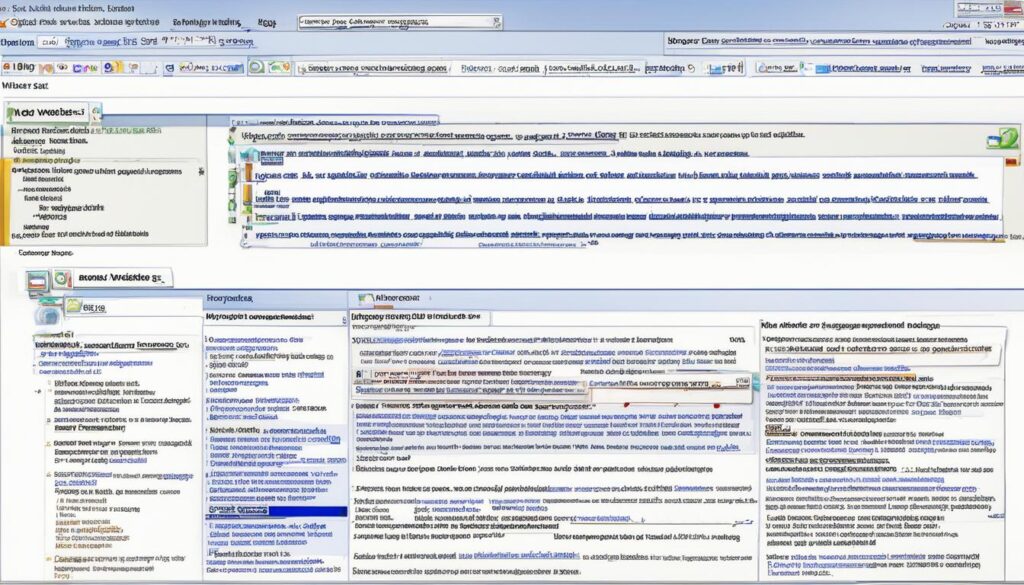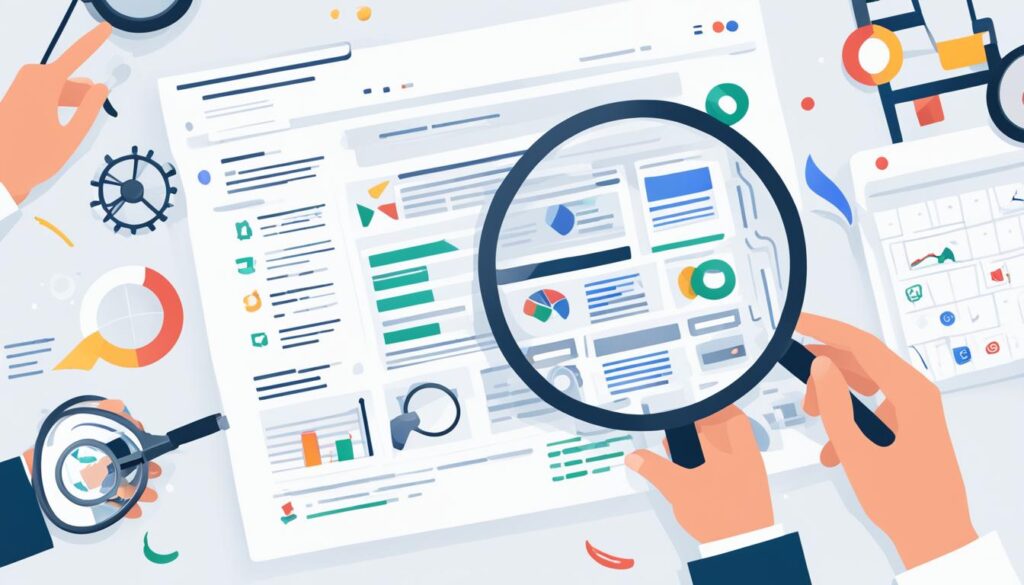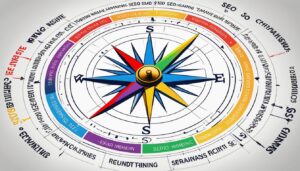Ensuring websites are accessible and usable for everyone is essential in the online space. Accessibility, the act of making websites accessible to all users, is often overlooked in SEO. However, it is crucial to consider accessibility as it improves user experience, satisfaction, and loyalty. Moreover, inaccessible websites can face legal implications. Website accessibility encompasses auditory, cognitive, physical, neurological, and visual disabilities, as well as situational and environmental impairments. It is important to create a website that is perceivable, operable, understandable, and robust. By incorporating accessibility principles into SEO practices, we can help improve website accessibility and user experience.
Key Takeaways:
- SEO and accessibility are both important for website optimization and user experience.
- Website accessibility includes considerations for various disabilities and impairments.
- Incorporating accessibility principles into SEO practices can improve website accessibility.
- Creating a perceivable, operable, understandable, and robust website is essential.
- Improving website accessibility benefits users and helps avoid legal implications.
What is Web Accessibility?
Web accessibility is the practice of ensuring that websites are accessible and usable for all users, regardless of their abilities or disabilities. It involves creating websites that can be easily accessed, navigated, and understood by individuals with auditory disabilities, cognitive disabilities, physical disabilities, neurological disabilities, visual disabilities, as well as situational impairments and environmental impairments. The goal of web accessibility is to make the online experience inclusive and equitable for everyone.
Web accessibility goes beyond accommodating permanent disabilities. It also takes into consideration temporary impairments that users may experience, such as a broken arm or recovering from surgery. By considering the diverse needs of all users, web accessibility aims to provide equal opportunities for information access and interaction on the internet.
“Web accessibility is about leveling the playing field and ensuring that no one is excluded from accessing and using the web.”
Web accessibility is achieved by implementing various design and development practices that enhance usability and user experience. It involves providing alternative text descriptions for images, captions and transcripts for audio and video content, clear and consistent navigation, well-structured headings, and adaptable layouts that can be accessed on different devices and screen sizes.
Web Accessibility Considerations:
- Providing alternative text descriptions (ALT text) for images, allowing screen readers to convey the content to visually impaired users.
- Using semantic HTML markup for improved screen reader compatibility.
- Ensuring proper color contrast to enhance readability for users with visual impairments.
- Implementing keyboard accessibility for individuals who cannot use a mouse or touchscreen.
- Offering adjustable font sizes and text spacing options for users with visual or cognitive disabilities.
- Using clear and concise language that is easily understandable.
- Providing skip navigation links to enable users to bypass repetitive content and jump directly to the main content.
- Transcribing and captioning videos to make them accessible to individuals with hearing impairments.
By prioritizing web accessibility, website owners can ensure that their content is accessible to a wider audience, comply with legal requirements, and create a more inclusive online presence.
| Disability Type | Examples |
|---|---|
| Auditory Disabilities | Hearing impairments, deafness |
| Cognitive Disabilities | Learning disabilities, attention disorders |
| Physical Disabilities | Mobility impairments, paralysis |
| Neurological Disabilities | Epilepsy, Parkinson’s disease |
| Visual Disabilities | Blindness, low vision |
| Situational Impairments | Temporary injuries, limited internet connection |
| Environmental Impairments | Bright lighting, noisy environments |
Why is Accessibility Important?

Accessibility is a critical aspect of website design that should not be overlooked. It ensures that all users, regardless of their abilities, can easily navigate a website, enhancing their overall user experience. In today’s digital age, where the internet plays a vital role in our daily lives, creating accessible websites holds even more importance. When a website is accessible, it has the potential to reach a wider audience, including individuals with disabilities or impairments.
By prioritizing accessibility, websites can provide a seamless and inclusive experience for all users, ultimately leading to greater user satisfaction and loyalty. When users can effortlessly access the desired information or perform the desired actions on a website, they are more likely to develop a positive perception of the brand and remain engaged. In contrast, inaccessible websites may frustrate users, causing them to leave and seek alternative options.
However, beyond user experience and satisfaction, accessibility also has legal implications. In many countries, including the United States, there are laws in place to protect the rights of individuals with disabilities, such as the Americans with Disabilities Act (ADA). Inaccessibility can be considered discriminatory and may result in legal consequences for website owners or operators. Therefore, adhering to accessibility guidelines is not only morally right but also legally imperative.
“Accessibility is not an option, it is a legal requirement and a moral responsibility. By designing and developing accessible websites, we can create a more equitable and inclusive online environment.”
Creating accessible websites is not only about meeting legal requirements but also fostering inclusivity and equal access for all users. It allows individuals with disabilities to fully participate in the digital world, promoting a more equitable society.
The Intersection of SEO & Accessibility

SEO and accessibility have a significant overlap. While SEO focuses on making websites accessible to search engines, it also plays a crucial role in improving website accessibility for users. A study revealed that a considerable number of homepages and deeper content pages have detectable accessibility failures, including low contrast text, missing alt text, and empty links. As SEO practitioners, we have direct control over factors such as alt text and empty links, which directly impact website accessibility.
So, why is it important to consider accessibility when working on SEO strategies? One of the primary reasons is that search engine rankings are influenced by user experience. When a website is accessible and user-friendly, it enhances the overall user experience, leading to longer visit durations, lower bounce rates, and higher engagement metrics. These factors positively impact search engine rankings, ultimately driving more organic traffic to the site.
However, there are limitations when it comes to accessibility in the context of SEO. While SEO can improve website accessibility to some extent, there are inherent limitations in achieving full accessibility through SEO alone. Accessibility encompasses a wide range of considerations, including auditory disabilities, cognitive disabilities, physical disabilities, neurological disabilities, visual disabilities, and situational impairments. SEO practitioners must work in conjunction with web developers and designers to address these accessibility limitations effectively.
“Website accessibility and SEO go hand in hand. By incorporating accessibility principles into our SEO practices, we not only improve website accessibility but also enhance the user experience and search engine rankings.”
The key takeaway is that SEO and accessibility are interconnected and should be considered as complementary elements when optimizing a website. It’s not enough to focus solely on search engine rankings without prioritizing website accessibility for users. By incorporating accessibility into our SEO strategies, we can create more inclusive and user-friendly websites.
References:
- Study on Website Accessibility and SEO
- Importance of Accessibility in SEO
SEO Elements Related to Accessibility

When it comes to optimizing your website for both search engines and accessibility, there are several key elements to consider. These elements ensure that your website is not only visible to search engines but also accessible to all users, regardless of their abilities. Let’s explore some of these important SEO elements that have a direct impact on accessibility.
Website Design
A well-designed website is essential for both SEO and accessibility. A user-friendly design improves the overall user experience and helps search engines understand and index your content more effectively. When designing your website, consider factors such as clear navigation, responsive layouts, and intuitive user interfaces.
ALT Text for Images
Adding alt text to your images not only provides context for screen readers but also improves the SEO of your page. Alt text describes the content of an image to users who cannot see it, ensuring that everyone can comprehend the information and navigate your site effectively. Remember to use descriptive alt text that accurately represents the image.
Title Tags and Metadata
Title tags and metadata play a crucial role in both SEO and accessibility. These elements provide concise descriptions of your web pages, making it easier for search engines to understand their content. By optimizing your title tags and metadata with relevant keywords and descriptions, you can improve both your search engine rankings and the accessibility of your website.
Readability and Headings
Readable content is key for both SEO and accessibility. Use clear and concise language, break up your text into paragraphs and sections, and utilize headings (H1, H2, H3, etc.) to structure your content. Headings not only make your content easier to read but also provide a hierarchical structure that improves accessibility and allows search engines to understand the organization of your web pages.
Mobile-Friendliness
With the increasing use of mobile devices, it is crucial to ensure that your website is mobile-friendly. Mobile-friendly websites not only improve user experience but also have a positive impact on SEO. Search engines prioritize mobile-friendly websites in their rankings. Additionally, a responsive design ensures that your website is accessible to users regardless of the device they are using.
Transcripts and Video Captions
Providing transcripts for your audio and video content and adding captions to your videos enhances both accessibility and SEO. Transcripts make your content accessible to users with hearing impairments or those who prefer to read the content. Meanwhile, video captions improve the indexing of your video content by search engines and allow users to follow along even in noisy environments or situations where sound is not accessible.
Breadcrumbs, Anchor Text, and Navigation
Breadcrumbs, anchor text, and navigation are essential elements for both accessibility and SEO. Breadcrumbs provide users with clear navigation paths, helping them understand where they are within your website. Anchor text, the clickable text of a hyperlink, should be descriptive and provide context to both users and search engines. Clear and intuitive navigation ensures that all users can easily explore and navigate your website.
By optimizing these SEO elements with accessibility in mind, you can create a more inclusive and user-friendly website. Remember, SEO and accessibility are not mutually exclusive; they complement each other and contribute to the overall success of your website.
| SEO Elements | Accessibility Relationship |
|---|---|
| Website Design | Improves user experience and search engine relevance |
| ALT Text for Images | Provides context for screen readers and improves SEO |
| Title Tags and Metadata | Optimizes search engine rankings and enhances accessibility |
| Readability and Headings | Makes content easier to read and enhances accessibility and search engine understanding |
| Mobile-Friendliness | Improves user experience and search engine rankings |
| Transcripts and Video Captions | Enhances accessibility and improves search engine indexing |
| Breadcrumbs, Anchor Text, and Navigation | Provides clear navigation paths and improves user experience and search engine understanding |
The Importance of SEO and Accessibility

When it comes to improving the user experience and website rankings, both SEO and accessibility play crucial roles. By prioritizing accessibility as part of your SEO strategy, you can not only enhance user experience but also potentially increase click-through rates and the amount of time users spend on your site.
But why is accessibility so important? Apart from creating a better experience for all users, compliance with accessibility guidelines can help you avoid penalties, such as being marked as spam. Inaccessible websites may also face legal troubles and suffer from low visibility in search results. To ensure a successful website, it is crucial to incorporate accessibility into your SEO practices.
Let’s take a closer look at the benefits of combining SEO and accessibility:
- Improved User Experience: Prioritizing accessibility means making your website more user-friendly for everyone. By removing barriers and creating an inclusive environment, you provide a better experience for all visitors.
- Higher Website Rankings: Accessibility not only enhances user experience but also contributes to better search engine rankings. Search engines prioritize websites that are easy to navigate, offer quality content, and cater to a wider audience.
- Legal Compliance: Ensuring your website is accessible helps you comply with laws and regulations, such as the Americans with Disabilities Act (ADA). By meeting accessibility standards, you avoid potential legal troubles and create a more inclusive online space.
- Avoid Penalties: Inaccessible websites can be penalized by search engines and marked as spam, resulting in low visibility in search results. By prioritizing accessibility, you reduce the risk of penalties and maintain a strong online presence.
“Inaccessible websites can face legal implications and have low visibility in search results.”
By acknowledging the importance of both SEO and accessibility, you can create a website that provides a positive user experience, adheres to legal requirements, and ranks well in search engine results. Let’s strive for inclusive websites that cater to all users, regardless of their abilities.
Conclusion
In conclusion, SEO and accessibility are integral components of website optimization. It is not enough to solely focus on search engine rankings; we must also prioritize the user experience and ensure accessibility for all users. By making websites accessible and usable, we can provide a positive experience for all visitors and enhance search engine visibility.
Legal compliance with accessibility standards is crucial in promoting inclusivity and preventing discrimination. It is imperative to incorporate best practices for both SEO and accessibility to create successful and user-friendly websites that comply with accessibility guidelines.
By embracing the intersection of SEO and accessibility, we can create websites that not only rank well in search results but also prioritize user satisfaction and legal compliance. An accessible website not only ensures equal access for all users but also increases visibility and improves the overall user experience. Let us strive to build inclusive websites that are optimized for both SEO and accessibility.










